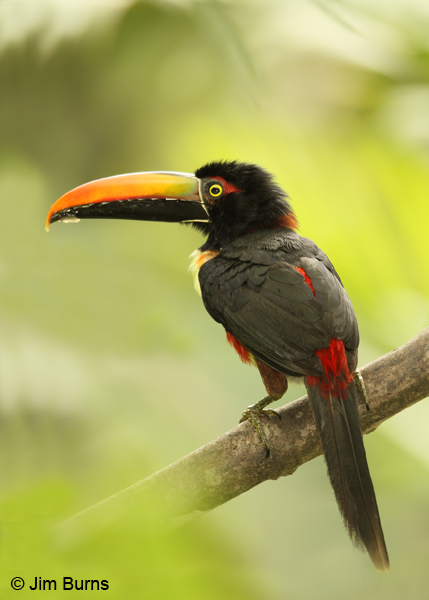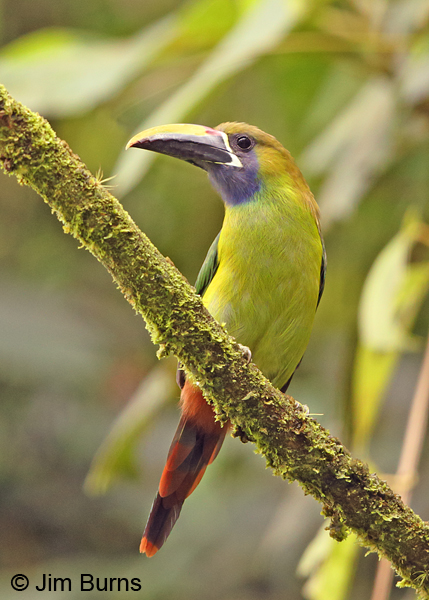
Nothing prepares the uninitiated for this third category. None in this category captures the imagination like the Ramphastidae, the barbets and toucans which have been called the quintessential neotropical birds, most of them recognized at a glance by their oversized and colorful bills. Whether or not one grew up eating Kellogg’s Froot Loops with the caricature, Toucan Sam, on the box, the toucan family will surely be the “must see” species on the first trip to Costa Rica, and the good news is that seven of the eight members of the family are considered “common” or “fairly common.”
Though lifelong North American birders, our first trip to Costa Rica was labeled a “cultural and environmental experience.” Nothing about that label prepared us, as we walked to breakfast through a Papaya grove in the turtle sanctuary that is Tortuguero National Park, for the raucous sounds and stunning sight of a flock of Collared Aracari feeding through the rain forest, stopping just yards away to break open and devour ripened fruit above us in the trees.
Let me set the scene: These are birds the size of crows, dorsally black, with black heads and throats but bright yellow underparts crossed by a wide black bar, a large black spot, and a crimson collar which circles the entire neck and matches the rump patch, the leggings, and the bare skin around the yellow eye. The huge beak, half the size of the bird’s body, sports a black lower mandible and a horn yellow upper mandible with a black tip and deep serrations with forward pointing teeth. A smattering of crimson highlights on the yellow ventral area perfectly match the ripe and rotting rind dripping from the broken Papaya fruit. Our first toucan! A palpable adrenaline rush. We were suddenly wide awake, and the non-birders in the group were gasping in awe. We knew right then our next Costa Rica trip would be just for the birds.
That beak, the signature feature on most of the toucan family, is light for its size, composed of bone struts surrounded by keratin, and has evolved for a purpose of course. These are forest birds with small wings and short tails, and the down curved and serrated beak allows them to conserve energy by sitting in one spot to pluck every berry within its wide range. Although primarily frugivorous (fruit eating), during nesting season toucans opportunistically seek protein to feed their young, and the size and shape of their marvelous beaks allow them to more easily reach into cavities and hanging baskets to plunder the eggs and nestlings of other birds.
We had a dramatic demonstration of just how adept the toucans are with these bills on our first real bird tour of Costa Rica. Glassing an area where a Harpy Eagle had been seen, we heard a noise behind us and discovered a Chestnut-mandibled Toucan feeding in the dense foliage of a fruiting tree. This is the largest of Costa Rica’s toucans, the size of a Red-tailed Hawk, with the largest toucan bill, spectacular bright yellow over rich brown as the common name suggests. With the very tip of this huge appendage, the bird was daintily plucking small red berries the size of cranberries!
We finally caught up, close and personal, with the most spectacular of the toucans at Laguna del Lagarto Lodge near Boca Tapado where the feeders attract Keel-bill Toucans. Keel-billeds are intermediate in size between Chestnut-mandibled and the aracaris, but their bills are other worldly. This is a black bird with a bright yellow face and chest, and the lime green, keeled bill appears to have been filled in by pre-schoolers. The upper mandible has an orange stripe, the lower mandible goes soft blue in the middle, and both end in a crimson tip. The white rump and crimson collar add to the coloring book effect.
I have yet to mention our two favorite members of the family, Fiery-billed Aracari and Emerald Toucanet. The former is similar to the Collared, but has a wider, crimson belly band, and its upper mandible glows fiery orange-red for most of its length. We saw our first Fiery-billeds on the Osa Peninsula shortly after fording a rocky, raging glacial river to reach the Bosque del Rio Tigre Lodge, and these foraging aracaris added an exotic touch to the sense of splendid isolation travelers feel on the Osa, labeled one of the most “biologically intense” places on the earth by National Geographic Magazine.
Emerald Toucanet graces the cover of the most popular Costa Rica field guide, so it often becomes the first “must see” target for birders new to the country. Toucans are cavity nesters, utilizing tree hollows and woodpecker excavations, and we staked out a potential toucanet nest hole for several days to no avail before finally seeing one in the forests of Tapanti National Park. The size of a large jay, fairly common and very vocal, Emerald Toucanet undoubtedly proved more elusive than the toucans and aracaris, because it is the only primarily green toucan in a country known for its shade dappled, green mountain forests. The toucanet bill, though smaller and less spectacular than that of its larger relatives, is oversized and presents its own dramatic color palette, yellow over black, with a red patch at the base of the upper mandible, all set off by the bird’s blue throat.
Costa Rica’s two barbet species, Prong-billed and Red-headed, are included in the Ramphastidae family with the toucans, and share some of the physical features of the closely related woodpeckers. Similar in size to our more common North American woodpeckers, they have zygodactyl feet (two toes forward, two facing backwards) for enhanced climbing ability, large heads on short necks, and large, stout, pointed bills surrounded by bristles. Though much smaller proportionally than the toucan bills, which are not at all evolved for excavating, the barbet bill is built big for digging out nests in trees, banks, and termite mounds.
Prong-billed Barbet is a rather plain bird whose common name says it all. Its bill is anything but plain, large and sharply tipped at the ends of both mandibles which cross much like those of our crossbills, adaptations designed for removing and then prying open the tropical fruit which is the mainstay of its diet. Though its colors are not eye catching like the toucans, it exhibits a burnt orange crown and cheek patch and a red eye. “Anything but plain” describes the plumage of the male Red-headed Barbet, whose scarlet head and breast and large yellow bill always catch the eye, even in the dark interior of its cloud forest habitat, which is where we saw our first one feeding in a drenching rain.
If you’re keeping score at home, you’ll realize we’ve seen seven of the Ramphastidae family though there are eight shown in the Costa Rican guides. On multiple trips we’ve of course missed Harpy Eagle, which is rare in Costa Rica now and may require going to Panama, and we’ve only seen one of the eight Formicariidae, the ground antbirds which include the antpittas and antthrushes, all uncommon to rare, all totally elusive skulkers of the forests’ floor. As exciting and as certain as that makes future Costa Rica bird forays, it is the missing member of the toucan family, the uncommon to rare Yellow-eared Toucanet which is now atop our CR “want list.”
Let me set a future scene: this toucanet is larger than the Emerald, almost the size of the aracaris, dorsally olive, black on the crown, chest, and belly, with a ruby rump patch and a splash of orange on the flanks. The typically oversized toucan beak is horn yellow over brown and yes, the male sports its namesake large swath of yellow feathers which flare out behind the fluorescent blue-green bare skin patch surrounding the red eye, and cover the entire side of the face. Smashing!
We’ll probably look first around the slopes of Arenal Volcano or on the steep, muddy trails out of Heliconias Lodge near Bijagua de Upala. Hope to see you there too.